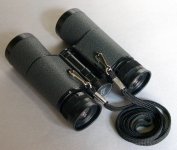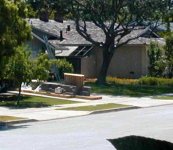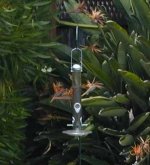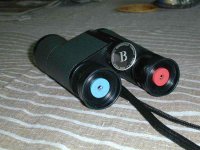elkcub
Silicon Valley, California

Retinal Offset and Field-of-View Effects on Apparent Size and Depth Using Binoculars
Several threads have discussed perceptual effects of porro vs. roof prism binoculars. The common observation is that porros induce smaller perceived images and greater spatial depth. Unfortunately, in addition to the greater retinal disparity provided by porros, another variable often distinguishes them from roofs, namely field-of-view (FOV). Generally, (but not always) porros have a larger field. Although several observers have commented that FOV has no effect on these phenomena, my own opinions have been more guarded. This is primarily because, as an experimental psychologist, I know that virtually nothing has a null effect on visual experience. The issue, to me, is not so much whether it has an influence, but how discernable is it? The problem to this point was that I didn't have an easy way to separate the two variables, namely retinal disparity and FOV.
Fortunately, I was recently able to acquire a dated (c. 1980) Bushnell 8x30 "Broadfield Compact" roof prism with a FOV of 8.5 deg. This exactly matches the 8.5 deg. FOV spec. of my Nippon Kogaku (Nikon) "Mikron" (c.1960). The latter is what I had used to verify the smaller image and greater depth of a porro when compared with my 7.8 deg. FOV 8x30 SLC Mk II (c. 1993). Optically the Bushnell is not in the same league as either the Nikon or Swaro. Not being phase coated it presents a darker view, but does appear to have coated glass and BAK-4 prisms. Bushnell was kind enough to clean and align it on a complementary basis, for which I am most grateful. My less than perfect measurements with a ruler indicate that the 30 mm objectives and 3.75 mm exit pupils matched sufficiently to conduct perception trials. (The critic will note that the design is incomplete, since a narrow field porro is missing. This would have involved finding an 8x30 porro with a 7.8 deg. FOV to match the Swaro, however, which was beyond my level of dedication.)
It took me some time to settle on procedures, but in the end I decided on viewing a scene centered at 60 yd. (180 ft.). Admittedly, this was partly because I could do the work while seated at my desk, looking at a house and driveway diagonally across the street. Several natural and man-made objects were conveniently located so that shading, perspective, and color contrast cues were all present, and an expanse of lawn allowed for assessing depth. The view spanned a range, near to far, of approximately 25—75 yd, with binoculars focused on objects at 60 yd.
In order to assess relative perceived size and spatial depth, the scenes were viewed both binocularly and monocularly. Since the order of comparison might be expected to influence the findings, trials were conducted by first looking at the scene through the SLC for 5 sec. of mental adaptation, and then switching to either the Nikon or Bushnell. Judgments of size and depth change were based on my immediate perceptions after the switch, and not after a studied view. (This is important to note for others attempting the experiment.) A second and third set of comparisons was made looking through the Bushnell and Nikons first and then switching to the others. In each comparison sequence one would expect the Porro images to appear smaller and have greater depth than either roof, and the two roofs to appear of equal size and depth compared to each other — that is, if FOV had no effect.
60 Yard Results (binocular viewing). Results are numbered with b = binocular.
1b. Looking at the scene first with the Swaro (roof) and then switching to the Nikon (porro), there was a distinct decrease in object size and increase of depth. This is consistent with earlier BF discussions.
2b. Switching to the Bushnell (roof) from the Swaro, however, there was almost an equal decrease in size and somewhat smaller increase in depth.
3b. Looking at the scene first with the Bushnell (roof), and then switching to the Nikon (porro) there was a slight decrease in size (smaller than #1b), and some increase in depth (also smaller than #1b).
4b. Switching to the Swaro from the Bushnell, there was a modest size increase in size and slight decrease in depth.
5b. Switching to the Swaro from the Nikon, there was a substantial increase in size and decrease in depth (basically the inverse of #1b).
6b. Switching to the Bushnell from the Nikon there was a small increase in size and decrease in depth.
These trials were repeated several times, but the alignment of the Bushnell was still not right and I was fighting off headaches. However,
• The wide FOV roof prism binocular produced similar size and depth perceptions as the porro having the same FOV.
• The narrow FOV roof produced greater size and less depth than a wide-field roof binocular.
Conclusion 1: Retinal offset and FOV jointly influence size and depth perceptions using binoculars at this distance.
Method Note: It is somewhat easier to perceive a decrease in size than an increase, and an increase in depth than a decrease.
60 Yard Results (monocular viewing).
Monocular viewing should put all binoculars on an equal footing if retinal offset accounts for all the perceptual size and depth effects. In this case I only used my dominant left eye, but the right eye matches pretty closely. Results are numbered with m = monocular.
1m. Looking first with the Swaro (roof) and then switching to the Nikon (porro), there was a distinct decrease in object size and moderate increase in depth. Yup, even with one eye.
2m. Switching to the Bushnell (roof) from the Swaro, there was almost an equal decrease in size and moderate increase in depth (slightly more than #1b actually).
3m. Looking with the Bushnell (roof), and then switching to the Nikon (porro) little apparent change in size or depth.
4m. Switching to the Swaro from the Bushnell, both roofs, there was a moderate size increase and small decrease in depth.
5m. Switching to the Swaro from the Nikon there was a moderate size increase and small depth increase.
6m. Switching to the Bushnell from the Nikon there was no clear change in size or depth.
Some of these perceptions were very subtle, like 3m and 6m, however:
Conclusion 2. Size and depth clearly change as a function of FOV difference between the binoculars.
Additional trials at 60 yd. (winking). Results numbered w = winking.
After doing the monocular trials I couldn't resist winking trials, or opening and closing the second eye. A brief period of adaptation is required for each binocular that takes 5 sec. or so to accomplish.
1w. Swaro. Closing one eye diminishes apparent size and depth. Opening both eyes does the opposite.
2w. Bushnell. (Images seem smaller than Swaro.) Nonetheless, closing one eye decreases apparent size and depth. Opening both eyes does the opposite.
3w. Nikon. (Images seem close in size to Bushnell, with greater depth.) Closing one eye decreases size and more strongly decreases depth than the Bushnell. Opening both eyes does the opposite.
The perceptual size effect for the Bushnell was similar to the Nikon’s, but the winking depth effect was somewhat stronger for the Nikon. Once adapted to the Swaro's larger apparent size, the winking effects were similar to the Bushnell’s.
Method note: One problem with doing winking experiments is that the combined visual fields change along with the image. There is nothing one can do about this since it results from the geometry of the head and eyes. Pure binocular or monocular procedures are better, IMO.
If anyone has had the fortitude to read this far, it should be evident that both the retinal offset and field-of-view has an effect on perceived image size and spatial depth using binoculars. Frankly, based on these observations I’m not sure which is more dominant at this viewing distance. The story might be different closer than 40 yd., so I’ll look at that next. However, the human perceptual system is regular as rain — very complicated!
Your comments would be appreciated. Yelling and screaming will not be tolerated (very well). It’s been fun though.
Best regards,
Elkcub
PS. Picture of Bushnell 8x30/8.5 "Broadfield" (c. 1980) shown.
Several threads have discussed perceptual effects of porro vs. roof prism binoculars. The common observation is that porros induce smaller perceived images and greater spatial depth. Unfortunately, in addition to the greater retinal disparity provided by porros, another variable often distinguishes them from roofs, namely field-of-view (FOV). Generally, (but not always) porros have a larger field. Although several observers have commented that FOV has no effect on these phenomena, my own opinions have been more guarded. This is primarily because, as an experimental psychologist, I know that virtually nothing has a null effect on visual experience. The issue, to me, is not so much whether it has an influence, but how discernable is it? The problem to this point was that I didn't have an easy way to separate the two variables, namely retinal disparity and FOV.
Fortunately, I was recently able to acquire a dated (c. 1980) Bushnell 8x30 "Broadfield Compact" roof prism with a FOV of 8.5 deg. This exactly matches the 8.5 deg. FOV spec. of my Nippon Kogaku (Nikon) "Mikron" (c.1960). The latter is what I had used to verify the smaller image and greater depth of a porro when compared with my 7.8 deg. FOV 8x30 SLC Mk II (c. 1993). Optically the Bushnell is not in the same league as either the Nikon or Swaro. Not being phase coated it presents a darker view, but does appear to have coated glass and BAK-4 prisms. Bushnell was kind enough to clean and align it on a complementary basis, for which I am most grateful. My less than perfect measurements with a ruler indicate that the 30 mm objectives and 3.75 mm exit pupils matched sufficiently to conduct perception trials. (The critic will note that the design is incomplete, since a narrow field porro is missing. This would have involved finding an 8x30 porro with a 7.8 deg. FOV to match the Swaro, however, which was beyond my level of dedication.)
It took me some time to settle on procedures, but in the end I decided on viewing a scene centered at 60 yd. (180 ft.). Admittedly, this was partly because I could do the work while seated at my desk, looking at a house and driveway diagonally across the street. Several natural and man-made objects were conveniently located so that shading, perspective, and color contrast cues were all present, and an expanse of lawn allowed for assessing depth. The view spanned a range, near to far, of approximately 25—75 yd, with binoculars focused on objects at 60 yd.
In order to assess relative perceived size and spatial depth, the scenes were viewed both binocularly and monocularly. Since the order of comparison might be expected to influence the findings, trials were conducted by first looking at the scene through the SLC for 5 sec. of mental adaptation, and then switching to either the Nikon or Bushnell. Judgments of size and depth change were based on my immediate perceptions after the switch, and not after a studied view. (This is important to note for others attempting the experiment.) A second and third set of comparisons was made looking through the Bushnell and Nikons first and then switching to the others. In each comparison sequence one would expect the Porro images to appear smaller and have greater depth than either roof, and the two roofs to appear of equal size and depth compared to each other — that is, if FOV had no effect.
60 Yard Results (binocular viewing). Results are numbered with b = binocular.
1b. Looking at the scene first with the Swaro (roof) and then switching to the Nikon (porro), there was a distinct decrease in object size and increase of depth. This is consistent with earlier BF discussions.
2b. Switching to the Bushnell (roof) from the Swaro, however, there was almost an equal decrease in size and somewhat smaller increase in depth.
3b. Looking at the scene first with the Bushnell (roof), and then switching to the Nikon (porro) there was a slight decrease in size (smaller than #1b), and some increase in depth (also smaller than #1b).
4b. Switching to the Swaro from the Bushnell, there was a modest size increase in size and slight decrease in depth.
5b. Switching to the Swaro from the Nikon, there was a substantial increase in size and decrease in depth (basically the inverse of #1b).
6b. Switching to the Bushnell from the Nikon there was a small increase in size and decrease in depth.
These trials were repeated several times, but the alignment of the Bushnell was still not right and I was fighting off headaches. However,
• The wide FOV roof prism binocular produced similar size and depth perceptions as the porro having the same FOV.
• The narrow FOV roof produced greater size and less depth than a wide-field roof binocular.
Conclusion 1: Retinal offset and FOV jointly influence size and depth perceptions using binoculars at this distance.
Method Note: It is somewhat easier to perceive a decrease in size than an increase, and an increase in depth than a decrease.
60 Yard Results (monocular viewing).
Monocular viewing should put all binoculars on an equal footing if retinal offset accounts for all the perceptual size and depth effects. In this case I only used my dominant left eye, but the right eye matches pretty closely. Results are numbered with m = monocular.
1m. Looking first with the Swaro (roof) and then switching to the Nikon (porro), there was a distinct decrease in object size and moderate increase in depth. Yup, even with one eye.
2m. Switching to the Bushnell (roof) from the Swaro, there was almost an equal decrease in size and moderate increase in depth (slightly more than #1b actually).
3m. Looking with the Bushnell (roof), and then switching to the Nikon (porro) little apparent change in size or depth.
4m. Switching to the Swaro from the Bushnell, both roofs, there was a moderate size increase and small decrease in depth.
5m. Switching to the Swaro from the Nikon there was a moderate size increase and small depth increase.
6m. Switching to the Bushnell from the Nikon there was no clear change in size or depth.
Some of these perceptions were very subtle, like 3m and 6m, however:
Conclusion 2. Size and depth clearly change as a function of FOV difference between the binoculars.
Additional trials at 60 yd. (winking). Results numbered w = winking.
After doing the monocular trials I couldn't resist winking trials, or opening and closing the second eye. A brief period of adaptation is required for each binocular that takes 5 sec. or so to accomplish.
1w. Swaro. Closing one eye diminishes apparent size and depth. Opening both eyes does the opposite.
2w. Bushnell. (Images seem smaller than Swaro.) Nonetheless, closing one eye decreases apparent size and depth. Opening both eyes does the opposite.
3w. Nikon. (Images seem close in size to Bushnell, with greater depth.) Closing one eye decreases size and more strongly decreases depth than the Bushnell. Opening both eyes does the opposite.
The perceptual size effect for the Bushnell was similar to the Nikon’s, but the winking depth effect was somewhat stronger for the Nikon. Once adapted to the Swaro's larger apparent size, the winking effects were similar to the Bushnell’s.
Method note: One problem with doing winking experiments is that the combined visual fields change along with the image. There is nothing one can do about this since it results from the geometry of the head and eyes. Pure binocular or monocular procedures are better, IMO.
If anyone has had the fortitude to read this far, it should be evident that both the retinal offset and field-of-view has an effect on perceived image size and spatial depth using binoculars. Frankly, based on these observations I’m not sure which is more dominant at this viewing distance. The story might be different closer than 40 yd., so I’ll look at that next. However, the human perceptual system is regular as rain — very complicated!
Your comments would be appreciated. Yelling and screaming will not be tolerated (very well). It’s been fun though.
Best regards,
Elkcub
PS. Picture of Bushnell 8x30/8.5 "Broadfield" (c. 1980) shown.
Attachments
Last edited:








